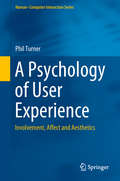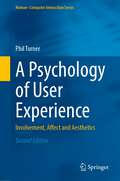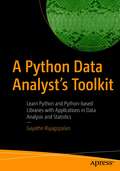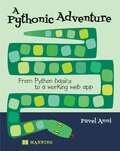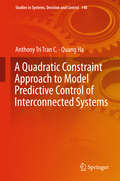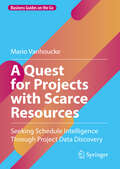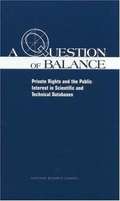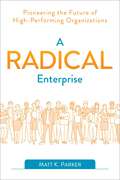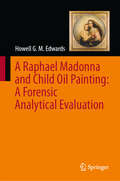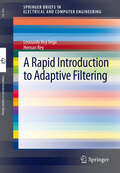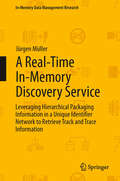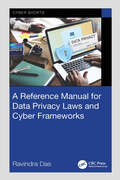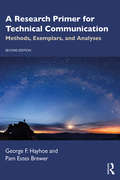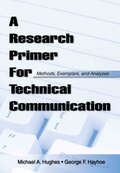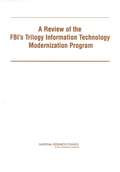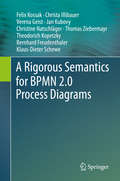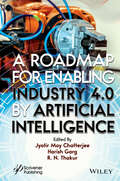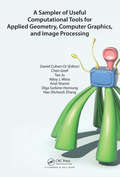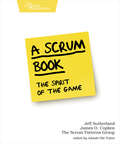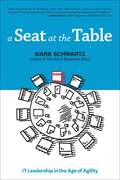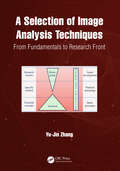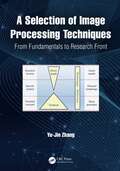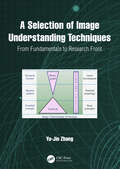- Table View
- List View
A Psychology of User Experience: Involvement, Affect and Aesthetics (Human–Computer Interaction Series)
by Phil TurnerIt is well-established that while cognitive psychology provides a sound foundation for an understanding of our interactions with digital technology, this is no longer sufficient to make sense of how we use and experience the personal, relational and ubiquitous technologies that pervade everyday life. This book begins with a consideration of the nature of experience itself, and the user experience (UX) of digital technology in particular, offering a new, broader definition of the term. This is elaborated though a wide-ranging and rigorous review of what are argued to be the three core UX elements. These are involvement, including shared sense making, familiarity, appropriation and "being-with" technologies; affect, including emotions with and about technology, impressions, feelings and mood; and aesthetics, including embodied aesthetics and neuroaesthetics. Alongside this, new insights are introduced into how and why much of our current use of digital technology is simply idling, or killing time. A particular feature of the book is a thorough treatment of parallel, and sometimes competing, accounts from differing academic traditions. Overall, the discussion considers both foundational and more recent theoretical and applied perspectives from social psychology, evolutionary psychology, folk psychology, neuroaesthetics, neuropsychology, the philosophy of technology, design and the fine arts. This broad scope will be enlightening and stimulating for anyone concerned in understanding UX. A Psychology of User Experience stands as a companion text to the author's HCI Redux text which discusses the contemporary treatment of cognition in human-computer interaction.
A Psychology of User Experience: Involvement, Affect and Aesthetics (Human–Computer Interaction Series)
by Phil TurnerAs mainstream psychology was never intended for the HCI practitioner, this second edition of A Psychology of User Experience takes the opportunity to create a new chapter specifically written for practitioners, that is, UX-oriented psychology rather than the all-too familiar everyday variety. For example, we discuss our two modes of cognition (fast / slow or controlled / automatic); we underline the importance of familiarity; and how and why we check our phones every few seconds day or night. We also establish the ‘context for user experience’ noting that just about everyone uses a cell phone and very many own a smartphone too and have done so for years (so, how did they learn to use them?). User experience reflects the current vogue for “designing for experience” within HCI which we recognise as something we feel rather than have reasoned about. In the real world, our feelings tell us how we are doing but with UX, they tell us how we feel about using digital technology. Topics are introduced to UX which maybe unfamiliar such as virtual experiences and virtual emotions and the affect associated with the uncontrolled use of digital technology.A Psychology of User Experience stands as a companion text to the author’s HCI Redux text which discusses the contemporary treatment of cognition in human-computer interaction.
A Python Data Analyst’s Toolkit: Learn Python and Python-based Libraries with Applications in Data Analysis and Statistics
by Gayathri RajagopalanExplore the fundamentals of data analysis, and statistics with case studies using Python. This book will show you how to confidently write code in Python, and use various Python libraries and functions for analyzing any dataset. The code is presented in Jupyter notebooks that can further be adapted and extended.This book is divided into three parts – programming with Python, data analysis and visualization, and statistics. You'll start with an introduction to Python – the syntax, functions, conditional statements, data types, and different types of containers. You'll then review more advanced concepts like regular expressions, handling of files, and solving mathematical problems with Python. The second part of the book, will cover Python libraries used for data analysis. There will be an introductory chapter covering basic concepts and terminology, and one chapter each on NumPy(the scientific computation library), Pandas (the data wrangling library) and visualization libraries like Matplotlib and Seaborn. Case studies will be included as examples to help readers understand some real-world applications of data analysis. The final chapters of book focus on statistics, elucidating important principles in statistics that are relevant to data science. These topics include probability, Bayes theorem, permutations and combinations, and hypothesis testing (ANOVA, Chi-squared test, z-test, and t-test), and how the Scipy library enables simplification of tedious calculations involved in statistics.What You'll LearnFurther your programming and analytical skills with PythonSolve mathematical problems in calculus, and set theory and algebra with PythonWork with various libraries in Python to structure, analyze, and visualize dataTackle real-life case studies using PythonReview essential statistical concepts and use the Scipy library to solve problems in statistics Who This Book Is ForProfessionals working in the field of data science interested in enhancing skills in Python, data analysis and statistics.
A Pythonic Adventure: From Python basics to a working web app
by Pavel AnniTime to take an adventure with friends! Team up with Erik and Simon to learn Python the easy way. This colorful book uses engaging questions and lively conversations to introduce computer programming to young readers one step at a time.In A Pythonic Adventure, you will learn useful Python skills like: Installing Python Working with files Creating text-based dialogs and menus Using if/then, loops, lists, dictionaries, and input/output Building web applications Making your web apps look super professional It&’s fun to learn with friends! In A Pythonic Adventure you&’ll meet Erik and Simon, two brothers who are just beginning their Python journey. Join them as they chat about the language, learn the basics, and build some cool programs. The book&’s dialogue helps young programmers understand complex concepts much more easily. It's the perfect way for young programmers (and their parents) to get started. There&’s no boring lessons or dull exercises in this adventure. You&’ll follow Erik and Simon&’s questions and mistakes, discover how to write programs with a team, and get a chance to create applications you can use in your daily life. By the time they&’re done reading, young learners will not only know how to write code, they&’ll know how to think about problems like professional developers. All code in this book runs on Mac, Windows, Linux, and Raspberry Pi. About the technology Computer programming is an adventure, full of new experiences, challenges, triumphs, and mistakes. In A Pythonic Adventure, you&’ll join brothers Erik and Simon as they learn to create their first Python program. Written especially for young readers, this book is the perfect introduction to a skill that will last a lifetime! About the book A Pythonic Adventure teaches you to code by asking questions, making errors, and trying out different solutions—just like in real life. As you go, you&’ll create a web application for a coffee shop step-by-step, from your first online menu to saving orders in a database. And this unique tutorial goes deeper than other beginner books. You&’ll learn and practice important skills like planning applications, finding bugs, and managing user expectations. What's inside Installing Python Creating text-based dialogs and menus Building web applications Making your web apps look professional About the reader For readers aged 10+. Perfect for adult beginners, too! About the author Pavel Anni is a Principal Customer Engineer at SambaNova Systems, and has also worked for Sun Microsystems, Oracle, and Red Hat. Table of Contents 1 Coffee for friends: First steps 2 Lists: What&’s on the menu? 3 Functions: Don&’t repeat yourself! 4 User errors: Everybody makes mistakes 5 Working with files: Being a shop manager 6 Main menu: Next customer! 7 Creating functions: Get the order and print it 8 Working with JSON: Save the order 9 Complete the menu: A real program 10 Learning Flask: Your first web application 11 Web form for orders: Coffee shop on the web 12 Database: We need good storage 13 Styles: Making it pretty 14 Help from AI: Improving our code 15 Next steps: Plans for the future
A Quadratic Constraint Approach to Model Predictive Control of Interconnected Systems (Studies In Systems, Decision And Control #148)
by Anthony Tri Tran C. Quang HaThis book focuses on the stabilization and model predictive control of interconnected systems with mixed connection configurations. It introduces the concept of dissipation-based quadratic constraint for developing attractivity assurance methods for interconnected systems. In order to develop these methods, distributed and decentralized architectures are employed, whereby the communication between subsystems is fully connected, partially connected, or completely disconnected. Given that the control inputs are entirely or partially decoupled between subsystems and no additional constraints are imposed on the interactive variables beyond the coupling constraint itself, the proposed approaches can be used with various types of systems and applications. Further, the book describes how the effects of coupling delays and data losses in device networks are resolved. From a practical perspective, the innovations presented are of benefit in applications in a broad range of fields, including the process and manufacturing industries, networked robotics, and network-centric systems such as chemical process systems, power systems, telecommunication networks, transportation networks, and, no less importantly, supply chain automation.
A Quest for Projects with Scarce Resources: Seeking Schedule Intelligence Through Project Data Discovery (Business Guides on the Go)
by Mario VanhouckeBased on the shared journey of two researchers, this book explores enhancing algorithms for the resource-constrained project scheduling problem. It examines the search for and significance of project data from multiple, distinct perspectives. In the first part, the quest for project data is presented as a continuous exploration of the complexity of the resource-constrained project scheduling problem. This quest is pursued by solving this challenging problem with the aid of state-of-the-art algorithms from the literature, each time gaining a deeper understanding of its challenging nature. To provide insights into the problem’s complexity, project data is created, manipulated, and analyzed in depth to make current projects easier or harder to schedule. This challenging quest for project data has resulted in new project databases for academic research, new ways of testing future algorithms, and insights into how to improve future algorithms to solve this project scheduling problem with limited resources. In turn, the second part discusses the relevance of project data, demonstrating to the reader the importance of the academic research presented in the first part for the professional world. It shows how project data can be used to calibrate real project data, leading to improved decision-making, e.g. for project scheduling, forecasting, and risk analysis. The book extends a warm invitation to academics and practitioners alike, as fellow seekers of knowledge, to enhance their project management skills.
A Question of Balance: Private Rights and the Public Interest in Scientific and Technical Databases
by Committee for a Study on Promoting Access to Scientific Technical Data for the Public InterestNew legal approaches, such as the European Union's 1996 Directive on the Legal Protection of Databases, and other legal initiatives now being considered in the United States at the federal and state level, are threatening to compromise public access to scientific and technical data available through computerized databases. Lawmakers are struggling to strike an appropriate balance between the rights of database rights holders, who are concerned about possible commercial misappropriation of their products, and public-interest users of the data such as researchers, educators, and libraries.A Question of Balance examines this balancing act. The committee concludes that because database rights holders already enjoy significant legal, technical, and market-based protections, the need for statutory protection has not been sufficiently substantiated. Nevertheless, although the committee opposes the creation of any strong new protective measures, it recognizes that some additional limits against wholesale misappropriation of databases may be necessary. In particular, a new, properly scoped and focused U.S. statute might provide a reasonable alternative to the European Union's highly protectionistic database directive. Such legislation could then serve as a legal model for an international treaty in this area. The book recommends a number of guiding principles for such possible legislation, as well as related policy actions for the administration.
A Radical Enterprise: Pioneering the Future of High-Performing Organizations
by Matt K. ParkerThe fastest growing and most competitive organizations in the world have no bureaucracies, no bosses, and no bullshit. The tomato sauce in your pantry. The raincoat in your closet. The smart TV hanging in your living room. What do all of these products have in common? Chances are they were created by organizations where colleagues self-allocate into teams based on intrinsic motivation. Where individuals self-manage their commitments to each other without the coercion of managers. And where teams launch new products and ventures on the market without the control of leaders.These organizations represent a new, radically collaborative breed of corporation. Recently doubling in number and already comprising 8% of corporations around the world, scientists and researchers have discovered that radically collaborative organizations are more competitive on practically every meaningful financial measure. They enjoy higher market share, higher innovation, and higher customer satisfaction than their traditional corporate competitors—and they also enjoy higher engagement, loyalty, and motivation from their employees. In this groundbreaking book, technology thought leader and organizational architect Matt K. Parker breaks down the counterintuitive principles and practices that radically collaborative organizations thrive on. By combining the latest insights from organizational science, sociology, and psychology, he illuminates four imperatives that all radically collaborative organizations must embrace in order to succeed: team autonomy, managerial devolution, deficiency gratification, and candid vulnerability. Millions of workers around the world are collapsing under the weight of command-and-control culture. The crisis has reached its breaking point. Now is the time to embrace radical change. Discover the revolutionary shift to partnership and equality and the economic superiority that follows with A Radical Enterprise.
A Raphael Madonna and Child Oil Painting: A Forensic Analytical Evaluation
by Howell G. EdwardsThis book presents a comprehensive forensic analysis of an oil painting depicting a Madonna and Child in a tondo format, previously thought to be a Victorian copy. Detailed historical and scientific studies confirm that this painting was, in fact, created by Raphael around 1512 as a study for his renowned Sistine Madonna, commissioned by Pope Julius II as an altarpiece for the monastic church of San Sisto in Piacenza. The painting underwent rigorous forensic examination, combining historical research with both invasive and non-invasive scientific imaging techniques. The analysis utilized advanced physical and chemical instrumentation to determine the painting's authenticity and accurate chronological placement. A comparative review of published chemical analyses of pigments, dyes, and substrates used in Raphael’s works from collections worldwide is included. Additionally, this study explores the innovative use of artificial intelligence (AI) for facial comparison between the figures in the tondo painting, the Sistine Madonna, and other Raphael artworks. These AI-generated insights provide novel information about the identities of Raphael’s models and shed light on his working techniques, as well as those of his associates.
A Rapid Introduction to Adaptive Filtering (SpringerBriefs in Electrical and Computer Engineering)
by Hernan Rey Leonardo Rey VegaIn this book, the authors provide insights into the basics of adaptive filtering, which are particularly useful for students taking their first steps into this field. They start by studying the problem of minimum mean-square-error filtering, i.e., Wiener filtering. Then, they analyze iterative methods for solving the optimization problem, e.g., the Method of Steepest Descent. By proposing stochastic approximations, several basic adaptive algorithms are derived, including Least Mean Squares (LMS), Normalized Least Mean Squares (NLMS) and Sign-error algorithms. The authors provide a general framework to study the stability and steady-state performance of these algorithms. The affine Projection Algorithm (APA) which provides faster convergence at the expense of computational complexity (although fast implementations can be used) is also presented. In addition, the Least Squares (LS) method and its recursive version (RLS), including fast implementations are discussed. The book closes with the discussion of several topics of interest in the adaptive filtering field.
A Real-Time In-Memory Discovery Service: Leveraging Hierarchical Packaging Information in a Unique Identifier Network to Retrieve Track and Trace Information (In-Memory Data Management Research)
by Jürgen MüllerThe research presented in this book discusses how to efficiently retrieve track and trace information for an item of interest that took a certain path through a complex network of manufacturers, wholesalers, retailers, and consumers. To this end, a super-ordinate system called "Discovery Service" is designed that has to handle large amounts of data, high insert-rates, and a high number of queries that are submitted to the discovery service. An example that is used throughout this book is the European pharmaceutical supply chain, which faces the challenge that more and more counterfeit medicinal products are being introduced. Between October and December 2008, more than 34 million fake drug pills were detected at customs control at the borders of the European Union. These fake drugs can put lives in danger as they were supposed to fight cancer, take effect as painkiller or antibiotics, among others. The concepts described in this book can be adopted for supply chain management use cases other than track and trace, such as recall, supply chain optimization, or supply chain analytics.
A Reference Manual for Data Privacy Laws and Cyber Frameworks (Cyber Shorts)
by Ravindra DasAs the world is becoming more digital and entwined together, the cybersecurity threat landscape has no doubt become a daunting one. For example, typical threat variants of the past, especially those of phishing, have now become much more sophisticated and covert in nature. A lot of this has been brought on by the proliferation of ransomware, which exploded during the COVID-19 pandemic. Now, there is another concern that is looming on the horizon: data privacy. Now, more than ever, consumers on a global basis want to know exactly what is happening to their personal identifiable information (PII) datasets. Examples of what they want to know about include the following: What kinds and types of information and data are being collected about them How those PII datasets are being stored, processed, and transacted with How their PII datasets are being used by third-party suppliers In response to these concerns and fears, as well as the cyber risks posed by these datasets, many nations around the world have set up rather extensive and very detailed data privacy laws. In their respective tenets and provisions, these pieces of legislation not only specify why and how businesses need to comply with them, but also outline the rights that are afforded to each and every consumer. In this book, we detail the tenets and provisions of three key data privacy laws: The GDPR The CCPA The CMMC We also provide a general framework at the end on how a business can comply with these various data privacy laws.The book begins with an in-depth overview of the importance of data and datasets, and how they are so relevant to the data privacy laws just mentioned.
A Research Primer for Technical Communication: Methods, Exemplars, and Analyses
by Pam Estes Brewer George F HayhoeThis fully revised edition provides a practical introduction to research methods for anyone conducting and critically reading technical communication research. The first section discusses the role of research in technical communication and explains in plain language how to conduct and report such research. It covers both quantitative and qualitative methods, as well as surveys, usability studies, and literature reviews. The second section presents a collection of research articles that serve as exemplars of these major types of research projects, each followed by commentary breaking down how it corresponds to the information on that research type. In addition to five new chapters of exemplars and commentaries, this second edition contains a new chapter on usability studies. This book is an essential introduction to research methods for students of technical communication and for industry professionals who need to conduct and engage with research on the job.
A Research Primer for Technical Communication: Methods, Exemplars, and Analyses
by George F. Hayhoe Michael A. HughesThis practical volume provides a thorough introduction to conducting and critically reading research in technical communication, complete with exemplars of research articles for study. Offering a solid grounding in the research underpinnings of the technical communication field, this resource has been developed for use in master’s level and upper-division undergraduate research methods courses in technical and professional communication.
A Review of the FBI's Trilogy Information Technology Modernization Program
by Committee on the FBI's Trilogy Information Technology Modernization ProgramThe Federal Bureau of Investigation (FBI) is in the process of developing a modern information technology (IT) system—the Trilogy program— that is designed to provide a high-speed network, modern workstations and software, and an application—the Virtual Case File (VCF)—to enhance the ability of agents to organize, access, and analyze information. Implementation of this system has encountered substantial difficulties, however, and has been the subject of much investigation and congressional concern. To help address these problems, the FBI asked the National Research Council (NRC) to undertake a quick review of the program and the progress that has been made to date. This report presents that review. The current status of four major aspects of the program—the enterprise architecture, system design, program management, and human resources—are discussed, and recommendations are presented to address the problems.
A Rigorous Semantics for BPMN 2.0 Process Diagrams
by Felix Kossak Christa Illibauer Verena Geist Jan Kubovy Christine Natschläger Thomas Ziebermayr Theodorich Kopetzky Bernhard Freudenthaler Klaus-Dieter ScheweThis book provides the most complete formal specification of the semantics of the Business Process Model and Notation 2. 0 standard (BPMN) available to date, in a style that is easily understandable for a wide range of readers - not only for experts in formal methods, but e. g. also for developers of modeling tools, software architects, or graduate students specializing in business process management. BPMN - issued by the Object Management Group - is a widely used standard for business process modeling. However, major drawbacks of BPMN include its limited support for organizational modeling, its only implicit expression of modalities, and its lack of integrated user interaction and data modeling. Further, in many cases the syntactical and, in particular, semantic definitions of BPMN are inaccurate, incomplete or inconsistent. The book addresses concrete issues concerning the execution semantics of business processes and provides a formal definition of BPMN process diagrams, which can serve as a sound basis for further extensions, i. e. , in the form of horizontal refinements of the core language. To this end, the Abstract State Machine (ASMs) method is used to formalize the semantics of BPMN. ASMs have demonstrated their value in various domains, e. g. specifying the semantics of programming or modeling languages, verifying the specification of the Java Virtual Machine, or formalizing the ITIL change management process. This kind of improvement promotes more consistency in the interpretation of comprehensive models, as well as real exchangeability of models between different tools. In the outlook at the end of the book, the authors conclude with proposing extensions that address actor modeling (including an intuitive way to denote permissions and obligations), integration of user-centric views, a refined communication concept, and data integration.
A Roadmap for Enabling Industry 4.0 by Artificial Intelligence
by Harish Garg Jyotir Moy Chatterjee R. N. ThakurA ROADMAP FOR ENABLING INDUSTRY 4.0 BY ARTIFICAIAL INTELLIGENCE The book presents comprehensive and up-to-date technological solutions to the main aspects regarding the applications of artificial intelligence to Industry 4.0. The industry 4.0 vision has been discussed for quite a while and the enabling technologies are now mature enough to turn this vision into a grand reality sooner rather than later. The fourth industrial revolution, or Industry 4.0, involves the infusion of technology-enabled deeper and decisive automation into manufacturing processes and activities. Several information and communication technologies (ICT) are being integrated and used towards attaining manufacturing process acceleration and augmentation. This book explores and educates the recent advancements in blockchain technology, artificial intelligence, supply chains in manufacturing, cryptocurrencies, and their crucial impact on realizing the Industry 4.0 goals. The book thus provides a conceptual framework and roadmap for decision-makers for implementing this transformation. Audience Computer and artificial intelligence scientists, information and communication technology specialists, and engineers in electronics and industrial manufacturing will find this book very useful.
A Roadmap to Industry 4.0: Smart Production, Sharp Business and Sustainable Development (Advances in Science, Technology & Innovation)
by Akshi Kumar Anand NayyarBusiness innovation and industrial intelligence are paving the way for a future in which smart factories, intelligent machines, networked processes and Big Data are combined to foster industrial growth. The maturity and growth of instrumentation, monitoring and automation as key technology drivers support Industry 4.0 as a viable, competent and actionable business model. This book offers a primer, helping readers understand this paradigm shift from industry 1.0 to industry 4.0. The focus is on grasping the necessary pre-conditions, development & technological aspects that conceptually describe this transformation, along with the practices, models and real-time experience needed to achieve sustainable smart manufacturing technologies. The primary goal is to address significant questions of what, how and why in this context, such as:What is Industry 4.0?What is the current status of its implementation?What are the pillars of Industry 4.0?How can Industry 4.0 be effectively implemented?How are firms exploiting the Internet of Things (IoT), Big Data and other emerging technologies to improve their production and services?How can the implementation of Industry 4.0 be accelerated?How is Industry 4.0 changing the workplace landscape?Why is this melding of the virtual and physical world needed for smart production engineering environments?Why is smart production a game-changing new form of product design and manufacturing?
A Sampler of Useful Computational Tools for Applied Geometry, Computer Graphics, and Image Processing
by Niloy J. Mitra Daniel Cohen-Or Chen Greif Tao Ju Olga Sorkine-Hornung Ariel Shamir Hao Richard ZhangA Sampler of Useful Computational Tools for Applied Geometry, Computer Graphics, and Image Processing shows how to use a collection of mathematical techniques to solve important problems in applied mathematics and computer science areas. The book discusses fundamental tools in analytical geometry and linear algebra. It covers a wide range of topics
A Science of Operations: Machines, Logic and the Invention of Programming (History of Computing)
by Mark PriestleyToday, computers fulfil a dazzling array of roles, a flexibility resulting from the great range of programs that can be run on them. A Science of Operations examines the history of what we now call programming, defined not simply as computer programming, but more broadly as the definition of the steps involved in computations and other information-processing activities. This unique perspective highlights how the history of programming is distinct from the history of the computer, despite the close relationship between the two in the 20th century. The book also discusses how the development of programming languages is related to disparate fields which attempted to give a mechanical account of language on the one hand, and a linguistic account of machines on the other. Topics and features: Covers the early development of automatic computing, including Babbage's "mechanical calculating engines" and the applications of punched-card technology, examines the theoretical work of mathematical logicians such as Kleene, Church, Post and Turing, and the machines built by Zuse and Aiken in the 1930s and 1940s, discusses the role that logic played in the development of the stored program computer, describes the "standard model" of machine-code programming popularised by Maurice Wilkes, presents the complete table for the universal Turing machine in the Appendices, investigates the rise of the initiatives aimed at developing higher-level programming notations, and how these came to be thought of as 'languages' that could be studied independently of a machine, examines the importance of the Algol 60 language, and the framework it provided for studying the design of programming languages and the process of software development and explores the early development of object-oriented languages, with a focus on the Smalltalk project. This fascinating text offers a new viewpoint for historians of science and technology, as well as for the general reader. The historical narrative builds the story in a clear and logical fashion, roughly following chronological order.
A Scrum Book: The Spirit of the Game
by James O. Coplien Jeff SutherlandBuilding a successful product usually involves teams of people, and many choose the Scrum approach to aid in creating products that deliver the highest possible value. Implementing Scrum gives teams a collection of powerful ideas they can assemble to fit their needs and meet their goals. The ninety-four patterns contained within are elaborated nuggets of insight into Scrum’s building blocks, how they work, and how to use them. They offer novices a roadmap for starting from scratch, yet they help intermediate practitioners fine-tune or fortify their Scrum implementations. Experienced practitioners can use the patterns and supporting explanations to get a better understanding of how the parts of Scrum complement each other to solve common problems in product development. The patterns are written in the well-known Alexandrian form, whose roots in architecture and design have enjoyed broad application in the software world. The form organizes each pattern so you can navigate directly to organizational design tradeoffs or jump to the solution or rationale that makes the solution work. The patterns flow together naturally through the context sections at their beginning and end. Learn everything you need to know to master and implement Scrum one step at a time—the agile way.
A Seat at the Table: IT Leadership in the Age of Agility
by Mark SchwartzAgile, Lean, and DevOps approaches are radical game changers, providing a fundamentally different way to think about how IT fits into the enterprise, how IT leaders lead, and how IT can harness technology to accomplish the objectives of the enterprise. But honest and open conversations are not taking place between management and Agile delivery teams.In A Seat at the Table, CIO Mark Schwartz explores the role of IT leadership as it is now and opens the door to reveal IT leadership as it should be—an integral part of the value creation engine. With an easy style, Schwartz reveals that the only way to become an Agile IT leader is to be courageous—to throw off the attitude and assumptions that have kept CIOs from taking their rightful seat at the table. CIOs, step on up, your seat at the table is waiting for you.
A Selection of Image Analysis Techniques: From Fundamental to Research Front
by Yu-Jin ZhangThis book focuses on seven commonly used image analysis techniques. It covers aspects from basic principles and practical methods, to new advancement of each selected technique to help readers solve image‐processing related problems in real-life situations. The selected techniques include image segmentation, segmentation evaluation and comparison, saliency object detection, motion analysis, mathematical morphology methods, face recognition and expression classification. The author offers readers a three‐step strategy toward problem‐solving: first, essential principles; then, a detailed explanation; and finally, a discussion on practical and working techniques for specific tasks. He also encourages readers to make full use of available materials from the latest developments and trends. This is an excellent book for those who do not have a complete foundation in image technology but need to use image analysis techniques to perform specific tasks in particular applications.
A Selection of Image Processing Techniques: From Fundamentals to Research Front
by Yu-Jin ZhangA Selection of Image Processing Techniques: From Fundamentals to Research Front focuses on seven commonly used image-processing techniques. These are de-noising, de-blurring, repairing, de-fogging, reconstruction from projection, watermarking, and super-resolution. This book is suitable for readers who do not have a complete foundation in the principles of image technology but need to use image techniques to solve specific tasks in particular applications. Hence, elementary knowledge for further study is provided, allowing the reader to discover suitable techniques for solving practical problems and to learn the latest developments in a specific domain. This book offers readers a three-step strategy toward problem solving: first, essential principles, then, a detailed explanation, and finally, a discussion of practical and working techniques for specific tasks. Throughout, the author highlights materials pertaining to the newest developments and trends of the technologies.
A Selection of Image Understanding Techniques: From Fundamentals to Research Front
by Yu-Jin ZhangThis book offers a comprehensive introduction to seven commonly used image understanding techniques in modern information technology. Readers of various levels can find suitable techniques to solve their practical problems and discover the latest development in these specific domains.The techniques covered include camera model and calibration, stereo vision, generalized matching, scene analysis and semantic interpretation, multi-sensor image information fusion, content-based visual information retrieval, and understanding spatial-temporal behavior. The book provides aspects from the essential concepts overview and basic principles to detailed introduction, explanation of the current methods and their practical techniques. It also presents discussions on the research trends and latest results in conjunction with new development of technical methods. This is an excellent read for those who do not have a subject background in image technology but need to use these techniques to complete specific tasks. These essential information will also be useful for their further study in the relevant fields.
